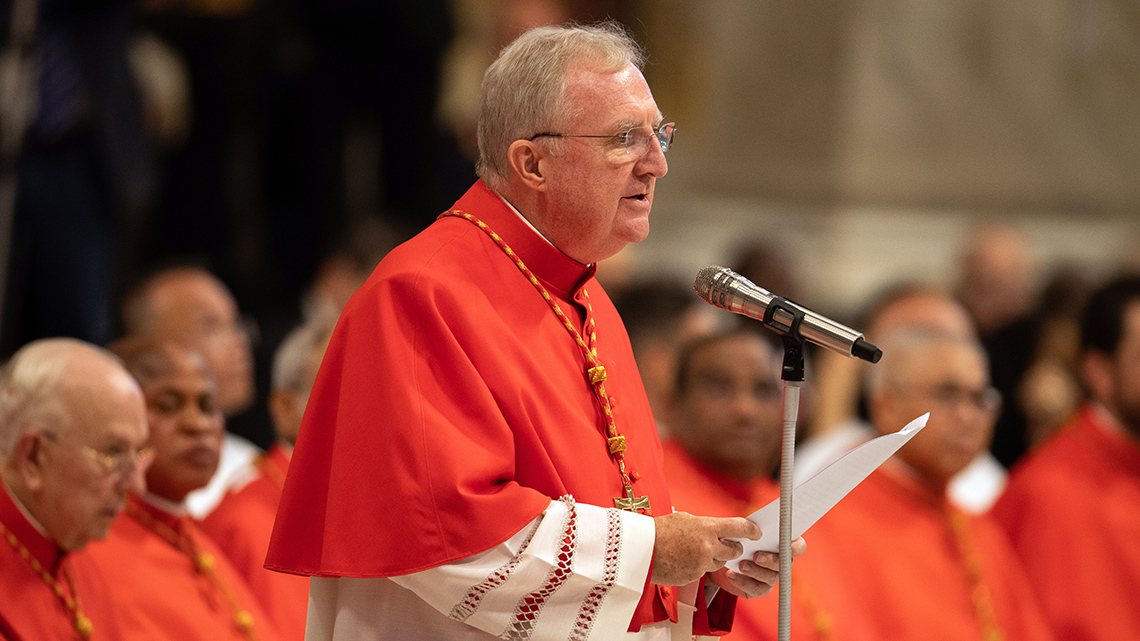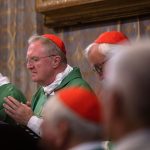
The Catholic Church in England and Wales now, remarkably, has three cardinals. Traditionally, the Archbishop of Westminster can expect to receive a red hat – and so it came to pass when Cardinal Vincent Nichols was created cardinal in 2014. Five years later, in 2019, Archbishop Michael Fitzgerald MAfr, who was President of the Vatican’s Pontifical Council for Interreligious Dialogue from 2002 to 2006, became England’s second living cardinal having returned to serve as a priest in Liverpool after half a century away. Now we have further cause for joy and celebration as our former Bishop of Leeds was created cardinal in an Ordinary Public Consistory on Saturday, 27 August 2022.
In this audio interview, Cardinal Arthur Roche, Prefect of the Vatican’s Dicastery for Divine Worship and the Discipline of the Sacraments, takes us through the occasion, explaining the role of cardinal and how he supports Pope Francis.

Transcript
My name is Cardinal Arthur Roche. I’m the prefect of the Dicastery for Divine Worship and the Discipline of the Sacraments.
Interviewer:
Tell us more about the Consistory…
Cardinal Roche:
Well, the Consistory was in two parts, as you know, the first part was the ceremonial, what they call the Ordinary Public Consistory, where the new cardinals are created. The Romans have a saying that God and the Holy Father have something in common, that they can both create something out of nothing. So that’s the good Italian humour that surrounds these events.
Then after the first public Consistory, where the new cardinals receive the biretta, which symbolises the fact that they should be prepared to die for the faith and in loyalty to the Pope, and a ring that binds them very closely to the office of the successor of St Peter, who is the Pope, then the title of a church. So I’ve become a parish priest after all these years and it was, in reality, the only thing that I ever wanted to be – to be amongst people, it’s the reason for our ordination.
My church is a very ancient church. It’s San Saba, which is built on the land which belonged to the mother of Saint Gregory the Great. Gregory the Great, as you know, is known as the Apostle of the English. So I’m really delighted by this coincidence, which of course is providence, that I’ve been given this church of San Saba that is so closely connected with our own history. I was also delighted that such a big number of parishioners, as well as their parish priest, came to greet me after the public Consistory in the Aula delle Benedizioni.
The second part of the Consistory is the Ordinary Consistory, which isn’t a public event, but it’s a meeting between the Holy Father and all the cardinals. This particular meeting was to look very carefully at the Apostolic Constitution Praedicate Evangelium, which was the remit given to the cardinals in 2013 when Pope Francis was elected. That remit was to reform the Roman Curia – to open it up in a special way and to reform its culture and indeed its purpose. So that has been done in this document, which is available for everybody to read, but what was particularly at the heart of our meeting was to look at how this affects the workings of Episcopal Conferences and individual bishops with the Sea of Peter.
A Catholic bishop is linked directly with the Pope and, in a very special way too, with the Holy See, through the various dicasteries that have been created. And one of the great changes is that there’s no hierarchical list amongst the dicasteries . All the dicasteries are equal – even though they have been put in a one, two, three, four sequence. It’s interesting that the very first dicastery, which previously has always been the Congregation for the Doctrine of the Faith, is now the Dicastery for Evangelisation, which combines the care of the missionary territories throughout the world and also the new evangelisation which was established by Pope John Paul II to reinvigorate the faith throughout Europe. So that was very much part and parcel of the discussions that have been taking place.
Partly how do bishops and Episcopal Conferences relate with the Holy See? Encouraging them to have the same level of trust and transparency that the Roman Curia is being asked to have towards them. And also to look at how this is going to affect the business of Episcopal Conferences and the business of the Roman Curia.
There are two elements to this, both missionary and conversion. So the work of preaching the Gospel, Praedicate Evangelium – the meaning of those Latin words, is to discover a way of being a missionary church in our world today – of being more outgoing, of being closer to people, of actually bringing with great gentleness, concern and for the dignity of every human being, the message of Christ. And in bringing that message, to bring them closer to the Lord.
The first duty of cardinals is to advise the Pope. The first duty is not to elect the Pope – that is a duty that comes when the Pope either retires or dies. That, we hope, is a long way away from us at this moment, but to advise the Pope. In order for that to happen, the Pope appoints individual cardinals as a member of other dicasteries. I’m already a member of four dicasteries. That’s a lot of work, because you have to contribute and think very carefully about their work and the questions that they raise and make a suitable response, not just using your own preference – this is my advice – but bringing into that advice the experiences that you gain through the work of being a Curial Cardinal.
Interviewer:
Do you think that we are spoiled in England and Wales now we have three cardinals?
Cardinal Roche:
It’s extraordinary, isn’t it, really? Someone was saying that it’s the first time it’s happened. I don’t know whether that’s true – historians will tell us whether that’s true. Normally, of course, in the past, the Archbishop of Westminster has always been a cardinal. That will not necessarily be the case in the future, because the Pope rather goes for individuals and he goes for the peripheries rather than for established cardinalatial sees like Westminster, Paris, Madrid and so on. But Cardinal Fitzgerald and I are both what you call Curial Cardinals. It’s quite remarkable that, in this moment, there should be three people from England. It’s good for England, it’s very good for our Bishops’ Conference, it’s very good for our bishops. The number of people who’ve written to me expressing enormous pride that this is a fruit of English Catholicism is overwhelming.